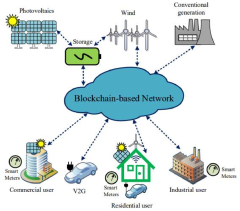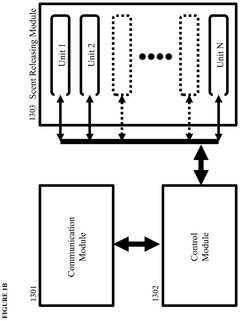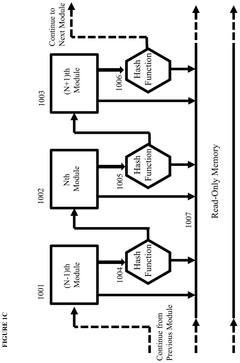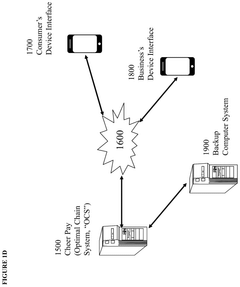The Intersection of Electromagnetic Waves and Blockchain Technology
JUL 11, 202510 MIN READ
Generate Your Research Report Instantly with AI Agent
Patsnap Eureka helps you evaluate technical feasibility & market potential.
EM-Blockchain Convergence: Background and Objectives
The convergence of electromagnetic waves and blockchain technology represents a groundbreaking frontier in the realm of digital innovation. This intersection has emerged as a result of the rapid advancements in both fields, driven by the increasing demand for secure, efficient, and decentralized communication systems. Electromagnetic waves, the foundation of wireless communication, have been utilized for over a century, evolving from basic radio transmissions to complex 5G networks. Blockchain, on the other hand, is a relatively new technology that has gained significant traction in the past decade, primarily due to its potential to revolutionize data security and transparency across various industries.
The primary objective of exploring this technological convergence is to leverage the strengths of both domains to create novel solutions that address current limitations in wireless communication and data management. By integrating blockchain's decentralized and immutable ledger system with electromagnetic wave technology, researchers and innovators aim to enhance the security, reliability, and efficiency of wireless data transmission and storage.
One of the key drivers behind this technological fusion is the growing concern over data privacy and security in an increasingly connected world. As the Internet of Things (IoT) continues to expand, the need for robust, tamper-proof communication protocols becomes more critical. The integration of blockchain with electromagnetic wave technology offers a promising avenue to address these concerns, potentially revolutionizing sectors such as telecommunications, finance, healthcare, and smart city infrastructure.
The evolution of this technological intersection can be traced back to the early 2010s when blockchain technology first gained prominence through cryptocurrencies. As blockchain's potential beyond financial applications became apparent, researchers began exploring its integration with existing communication technologies. The advent of 5G networks and the increasing focus on edge computing have further accelerated interest in this convergence, as these advancements require novel approaches to data management and security.
Looking ahead, the trajectory of this technological convergence is expected to lead to significant breakthroughs in areas such as secure wireless communication, decentralized network management, and tamper-proof data transmission. Potential applications include blockchain-secured IoT devices, decentralized spectrum management for 5G and beyond, and quantum-resistant communication protocols leveraging both blockchain and electromagnetic wave principles.
As we delve deeper into this technological landscape, it is crucial to understand the current state of both electromagnetic wave technology and blockchain, as well as the challenges and opportunities that arise from their intersection. This exploration will not only shed light on the potential transformative impact of this convergence but also guide future research and development efforts in this exciting and rapidly evolving field.
The primary objective of exploring this technological convergence is to leverage the strengths of both domains to create novel solutions that address current limitations in wireless communication and data management. By integrating blockchain's decentralized and immutable ledger system with electromagnetic wave technology, researchers and innovators aim to enhance the security, reliability, and efficiency of wireless data transmission and storage.
One of the key drivers behind this technological fusion is the growing concern over data privacy and security in an increasingly connected world. As the Internet of Things (IoT) continues to expand, the need for robust, tamper-proof communication protocols becomes more critical. The integration of blockchain with electromagnetic wave technology offers a promising avenue to address these concerns, potentially revolutionizing sectors such as telecommunications, finance, healthcare, and smart city infrastructure.
The evolution of this technological intersection can be traced back to the early 2010s when blockchain technology first gained prominence through cryptocurrencies. As blockchain's potential beyond financial applications became apparent, researchers began exploring its integration with existing communication technologies. The advent of 5G networks and the increasing focus on edge computing have further accelerated interest in this convergence, as these advancements require novel approaches to data management and security.
Looking ahead, the trajectory of this technological convergence is expected to lead to significant breakthroughs in areas such as secure wireless communication, decentralized network management, and tamper-proof data transmission. Potential applications include blockchain-secured IoT devices, decentralized spectrum management for 5G and beyond, and quantum-resistant communication protocols leveraging both blockchain and electromagnetic wave principles.
As we delve deeper into this technological landscape, it is crucial to understand the current state of both electromagnetic wave technology and blockchain, as well as the challenges and opportunities that arise from their intersection. This exploration will not only shed light on the potential transformative impact of this convergence but also guide future research and development efforts in this exciting and rapidly evolving field.
Market Demand Analysis for EM-Blockchain Solutions
The convergence of electromagnetic waves and blockchain technology has sparked significant interest across various industries, creating a burgeoning market for EM-blockchain solutions. This innovative intersection addresses critical challenges in secure communication, data integrity, and decentralized network management, driving demand from multiple sectors.
In the telecommunications industry, there is a growing need for enhanced security and efficiency in wireless communications. EM-blockchain solutions offer potential improvements in spectrum management, secure data transmission, and network optimization. Major telecom providers are exploring these technologies to bolster their infrastructure and service offerings, particularly in the context of 5G and future 6G networks.
The financial sector has shown keen interest in EM-blockchain solutions for secure transactions and fraud prevention. Banks and fintech companies are investigating the use of quantum-resistant encryption methods combined with blockchain to protect against potential threats from quantum computing. This demand is driven by the increasing value of digital assets and the need for foolproof security measures.
In the realm of Internet of Things (IoT), the market for EM-blockchain solutions is expanding rapidly. As the number of connected devices grows exponentially, there is a pressing need for secure, decentralized management of vast sensor networks. Industries such as smart manufacturing, agriculture, and smart cities are particularly interested in solutions that can ensure data integrity and resist electromagnetic interference.
The defense and aerospace sectors represent another significant market for EM-blockchain technologies. These industries require ultra-secure communication systems and tamper-proof data storage. EM-blockchain solutions offer potential advancements in military communications, drone swarm coordination, and satellite network management.
Healthcare is emerging as a promising market for EM-blockchain applications. There is a growing demand for secure, interoperable systems to manage patient data, medical devices, and pharmaceutical supply chains. EM-blockchain solutions could provide the necessary security and transparency while ensuring compliance with stringent healthcare regulations.
The energy sector, particularly in the context of smart grids and renewable energy management, is showing increased interest in EM-blockchain technologies. These solutions could enhance the security and efficiency of power distribution networks, facilitate peer-to-peer energy trading, and improve the integration of distributed energy resources.
While the market for EM-blockchain solutions is still in its early stages, industry analysts project significant growth in the coming years. The global market for blockchain in telecom and post services alone is expected to grow substantially, driven by the need for secure 5G implementation and efficient spectrum management. Similarly, the market for blockchain IoT solutions is anticipated to expand rapidly, fueled by the increasing adoption of smart devices and the need for robust security measures.
In the telecommunications industry, there is a growing need for enhanced security and efficiency in wireless communications. EM-blockchain solutions offer potential improvements in spectrum management, secure data transmission, and network optimization. Major telecom providers are exploring these technologies to bolster their infrastructure and service offerings, particularly in the context of 5G and future 6G networks.
The financial sector has shown keen interest in EM-blockchain solutions for secure transactions and fraud prevention. Banks and fintech companies are investigating the use of quantum-resistant encryption methods combined with blockchain to protect against potential threats from quantum computing. This demand is driven by the increasing value of digital assets and the need for foolproof security measures.
In the realm of Internet of Things (IoT), the market for EM-blockchain solutions is expanding rapidly. As the number of connected devices grows exponentially, there is a pressing need for secure, decentralized management of vast sensor networks. Industries such as smart manufacturing, agriculture, and smart cities are particularly interested in solutions that can ensure data integrity and resist electromagnetic interference.
The defense and aerospace sectors represent another significant market for EM-blockchain technologies. These industries require ultra-secure communication systems and tamper-proof data storage. EM-blockchain solutions offer potential advancements in military communications, drone swarm coordination, and satellite network management.
Healthcare is emerging as a promising market for EM-blockchain applications. There is a growing demand for secure, interoperable systems to manage patient data, medical devices, and pharmaceutical supply chains. EM-blockchain solutions could provide the necessary security and transparency while ensuring compliance with stringent healthcare regulations.
The energy sector, particularly in the context of smart grids and renewable energy management, is showing increased interest in EM-blockchain technologies. These solutions could enhance the security and efficiency of power distribution networks, facilitate peer-to-peer energy trading, and improve the integration of distributed energy resources.
While the market for EM-blockchain solutions is still in its early stages, industry analysts project significant growth in the coming years. The global market for blockchain in telecom and post services alone is expected to grow substantially, driven by the need for secure 5G implementation and efficient spectrum management. Similarly, the market for blockchain IoT solutions is anticipated to expand rapidly, fueled by the increasing adoption of smart devices and the need for robust security measures.
Current Challenges in EM-Blockchain Integration
The integration of electromagnetic (EM) waves and blockchain technology presents several significant challenges that researchers and developers must address. One of the primary obstacles is the inherent incompatibility between the physical nature of EM waves and the digital realm of blockchain. EM waves operate in the analog domain, while blockchain systems are fundamentally digital, creating a substantial gap in their integration.
A major challenge lies in the secure and efficient transmission of blockchain data using EM waves. The vulnerability of EM signals to interference, interception, and jamming poses risks to the integrity and confidentiality of blockchain transactions. Developing robust encryption and error correction techniques specifically tailored for EM-blockchain communication is crucial to overcome these security concerns.
Another significant hurdle is the scalability of EM-blockchain systems. As blockchain networks grow, the volume of data that needs to be transmitted via EM waves increases exponentially. This puts strain on the available EM spectrum and requires innovative solutions to optimize bandwidth usage and transmission efficiency. Researchers must explore advanced modulation techniques and spectrum allocation strategies to accommodate the growing demands of blockchain networks.
The energy consumption of both EM wave transmission and blockchain operations presents a substantial challenge. Blockchain systems, particularly those using proof-of-work consensus mechanisms, are already known for their high energy requirements. Combining this with the power needed for long-range EM wave transmission could result in unsustainable energy consumption levels. Developing energy-efficient protocols and hardware solutions is essential for the practical implementation of EM-blockchain integration.
Latency is another critical issue that needs to be addressed. Blockchain networks often require real-time or near-real-time transaction processing, while EM wave propagation introduces inherent delays, especially over long distances. Minimizing these delays and ensuring synchronization across the network is vital for maintaining the integrity and efficiency of blockchain operations.
The regulatory landscape surrounding EM spectrum usage and blockchain technology presents additional challenges. Different countries have varying regulations on spectrum allocation and blockchain applications, making it difficult to implement globally interoperable EM-blockchain systems. Navigating these regulatory complexities and working towards standardization is crucial for widespread adoption.
Lastly, the integration faces technical challenges in terms of hardware design and implementation. Developing devices capable of efficiently interfacing between EM wave communication systems and blockchain nodes requires interdisciplinary expertise in antenna design, signal processing, and blockchain protocols. Creating compact, cost-effective, and reliable hardware solutions that can operate in diverse environmental conditions remains a significant engineering challenge.
A major challenge lies in the secure and efficient transmission of blockchain data using EM waves. The vulnerability of EM signals to interference, interception, and jamming poses risks to the integrity and confidentiality of blockchain transactions. Developing robust encryption and error correction techniques specifically tailored for EM-blockchain communication is crucial to overcome these security concerns.
Another significant hurdle is the scalability of EM-blockchain systems. As blockchain networks grow, the volume of data that needs to be transmitted via EM waves increases exponentially. This puts strain on the available EM spectrum and requires innovative solutions to optimize bandwidth usage and transmission efficiency. Researchers must explore advanced modulation techniques and spectrum allocation strategies to accommodate the growing demands of blockchain networks.
The energy consumption of both EM wave transmission and blockchain operations presents a substantial challenge. Blockchain systems, particularly those using proof-of-work consensus mechanisms, are already known for their high energy requirements. Combining this with the power needed for long-range EM wave transmission could result in unsustainable energy consumption levels. Developing energy-efficient protocols and hardware solutions is essential for the practical implementation of EM-blockchain integration.
Latency is another critical issue that needs to be addressed. Blockchain networks often require real-time or near-real-time transaction processing, while EM wave propagation introduces inherent delays, especially over long distances. Minimizing these delays and ensuring synchronization across the network is vital for maintaining the integrity and efficiency of blockchain operations.
The regulatory landscape surrounding EM spectrum usage and blockchain technology presents additional challenges. Different countries have varying regulations on spectrum allocation and blockchain applications, making it difficult to implement globally interoperable EM-blockchain systems. Navigating these regulatory complexities and working towards standardization is crucial for widespread adoption.
Lastly, the integration faces technical challenges in terms of hardware design and implementation. Developing devices capable of efficiently interfacing between EM wave communication systems and blockchain nodes requires interdisciplinary expertise in antenna design, signal processing, and blockchain protocols. Creating compact, cost-effective, and reliable hardware solutions that can operate in diverse environmental conditions remains a significant engineering challenge.
Existing EM-Blockchain Integration Approaches
01 Blockchain-based electromagnetic wave communication systems
Integration of blockchain technology with electromagnetic wave communication systems to enhance security, data integrity, and decentralized management of wireless networks. This approach can improve the reliability and efficiency of wireless communications while leveraging the benefits of distributed ledger technology.- Blockchain-based electromagnetic wave communication systems: Integration of blockchain technology with electromagnetic wave communication systems to enhance security, data integrity, and decentralized management of wireless networks. This approach can improve the reliability and efficiency of wireless communications while leveraging the benefits of distributed ledger technology.
- Electromagnetic wave detection and analysis using blockchain: Utilization of blockchain technology for secure and transparent recording, storage, and analysis of electromagnetic wave data. This can be applied in various fields such as environmental monitoring, spectrum management, and electromagnetic interference detection.
- Blockchain-powered electromagnetic energy harvesting and distribution: Implementation of blockchain technology to manage and optimize the harvesting, storage, and distribution of electromagnetic energy. This can lead to more efficient and decentralized energy systems, particularly in the context of wireless power transfer and smart grids.
- Electromagnetic shielding and protection using blockchain: Application of blockchain technology to enhance electromagnetic shielding and protection systems. This can involve secure logging of shielding effectiveness, smart contracts for automated maintenance, and decentralized management of electromagnetic compatibility measures.
- Blockchain-based electromagnetic spectrum management: Utilization of blockchain technology for efficient and transparent management of the electromagnetic spectrum. This can include decentralized allocation of frequency bands, secure licensing processes, and real-time monitoring of spectrum usage to prevent interference and optimize resource allocation.
02 Electromagnetic wave detection and monitoring using blockchain
Utilization of blockchain technology for secure and transparent recording of electromagnetic wave detection and monitoring data. This can be applied in various fields such as environmental monitoring, spectrum management, and electromagnetic interference detection, ensuring data immutability and traceability.Expand Specific Solutions03 Blockchain-powered electromagnetic energy harvesting and distribution
Implementation of blockchain technology in electromagnetic energy harvesting and distribution systems. This approach can enable efficient management of energy resources, facilitate peer-to-peer energy trading, and enhance the overall reliability and transparency of energy distribution networks.Expand Specific Solutions04 Electromagnetic shielding solutions using blockchain
Development of blockchain-based systems for managing and verifying electromagnetic shielding solutions. This can include tracking the production, installation, and performance of shielding materials, as well as ensuring compliance with electromagnetic compatibility standards through immutable record-keeping.Expand Specific Solutions05 Blockchain-enhanced electromagnetic spectrum management
Application of blockchain technology to improve electromagnetic spectrum management and allocation. This can involve creating decentralized systems for spectrum licensing, dynamic spectrum access, and interference mitigation, leading to more efficient use of the electromagnetic spectrum and reduced conflicts between users.Expand Specific Solutions
Key Players in EM-Blockchain Research and Development
The intersection of electromagnetic waves and blockchain technology represents an emerging field with significant potential for innovation and disruption. This nascent sector is in its early stages of development, characterized by exploratory research and proof-of-concept implementations. The market size is currently limited but projected to grow rapidly as applications in secure communications, IoT, and wireless networks mature. While the technology is still evolving, several key players are driving advancements. Companies like Ant Blockchain Technology, Sony, and Ciena are leveraging their expertise in telecommunications and blockchain to develop novel solutions. Academic institutions such as Southeast University and North China Electric Power University are contributing fundamental research. As the technology matures, we can expect increased collaboration between industry leaders and research institutions to unlock its full potential.
Electronics & Telecommunications Research Institute
Technical Solution: ETRI has developed a blockchain-based electromagnetic interference (EMI) management system for smart cities. Their solution uses a network of IoT sensors to monitor electromagnetic wave emissions from various sources in urban environments. The sensor data is recorded on a blockchain, creating a tamper-proof record of EMI levels across the city. Smart contracts automatically trigger alerts and mitigation actions when EMI levels exceed predefined thresholds[9]. ETRI's system also incorporates machine learning algorithms to predict potential EMI hotspots and optimize the placement of EMI mitigation devices. The blockchain ensures transparency in EMI management, allowing city officials and residents to access real-time and historical EMI data[10].
Strengths: Improves urban electromagnetic environment management, provides transparency for stakeholders, and enables proactive EMI mitigation. Weaknesses: Requires extensive sensor deployment and may face privacy concerns regarding EMI data collection.
British Telecommunications Plc
Technical Solution: BT has developed a blockchain-based solution for securing electromagnetic wave communications in quantum networks. Their approach combines quantum key distribution (QKD) with blockchain technology to create a highly secure communication infrastructure. The system uses quantum entanglement to generate encryption keys, which are then recorded and managed on a blockchain network. This ensures the integrity and immutability of the key distribution process[7]. BT's solution also incorporates post-quantum cryptography algorithms to protect against future quantum computing threats. The blockchain network validates and logs all quantum key exchanges, providing a tamper-proof audit trail for regulatory compliance and security analysis[8].
Strengths: Provides quantum-resistant security for communications, scalable for large networks, and offers a robust audit trail. Weaknesses: Requires specialized quantum hardware and may have limited applicability in non-quantum environments.
Core Innovations in EM-Blockchain Synergy
Implementation of IoT in distribution network using blockchain outlook for smart homes
PatentPendingIN202341012885A
Innovation
- The integration of Blockchain technology with IoT to create a decentralized and secure platform for peer-to-peer energy trading and management, utilizing consensus algorithms and intelligent contracts to enhance the smartness of power grids, enabling efficient data exchange and local energy markets.
Computer record authentication system
PatentPendingUS20250106036A1
Innovation
- A computerized method using a hash function to create immutable, auditable, and continuous electronic records, stored in a read-only memory, which ensures data integrity and security, allowing for faster transaction processing and reduced energy consumption compared to Blockchain.
Regulatory Framework for EM-Blockchain Applications
The regulatory framework for electromagnetic-blockchain (EM-blockchain) applications is a complex and evolving landscape that requires careful consideration of both existing regulations and the need for new guidelines. As this emerging technology intersects two highly regulated fields, it faces unique challenges in terms of compliance and standardization.
Current regulations governing electromagnetic spectrum usage, such as those enforced by the Federal Communications Commission (FCC) in the United States, play a crucial role in shaping the development of EM-blockchain applications. These regulations typically focus on issues like frequency allocation, power limits, and interference prevention. However, they may need to be adapted to accommodate the specific requirements of blockchain-based systems that utilize electromagnetic waves for data transmission and validation.
Simultaneously, blockchain technology is subject to its own set of regulations, primarily centered around financial services, data protection, and cybersecurity. Regulatory bodies such as the Securities and Exchange Commission (SEC) and the Commodity Futures Trading Commission (CFTC) have been actively working to establish guidelines for blockchain-based assets and transactions. The integration of electromagnetic wave technology with blockchain systems introduces additional layers of complexity to these existing regulatory frameworks.
One of the key challenges in developing a comprehensive regulatory framework for EM-blockchain applications is addressing the potential security and privacy concerns. As these systems rely on electromagnetic waves for data transmission, there is an increased risk of interception and manipulation. Regulators must work closely with industry experts to establish robust encryption standards and secure communication protocols that can withstand both traditional and quantum-based attacks.
Another important aspect of the regulatory framework is the need for international cooperation and harmonization. Given the global nature of both electromagnetic spectrum usage and blockchain technology, it is crucial to develop consistent standards and regulations across different jurisdictions. This may involve the creation of international working groups or task forces dedicated to addressing the unique challenges posed by EM-blockchain applications.
Furthermore, the regulatory framework must be flexible enough to accommodate rapid technological advancements in both electromagnetic wave technology and blockchain systems. This may require the implementation of adaptive regulatory approaches, such as regulatory sandboxes or pilot programs, that allow for controlled experimentation and innovation while maintaining necessary safeguards.
As the field of EM-blockchain applications continues to evolve, it is likely that new regulatory bodies or specialized divisions within existing agencies will be established to oversee this emerging technology. These entities will need to possess expertise in both electromagnetic wave technology and blockchain systems to effectively regulate and guide the development of this innovative field.
Current regulations governing electromagnetic spectrum usage, such as those enforced by the Federal Communications Commission (FCC) in the United States, play a crucial role in shaping the development of EM-blockchain applications. These regulations typically focus on issues like frequency allocation, power limits, and interference prevention. However, they may need to be adapted to accommodate the specific requirements of blockchain-based systems that utilize electromagnetic waves for data transmission and validation.
Simultaneously, blockchain technology is subject to its own set of regulations, primarily centered around financial services, data protection, and cybersecurity. Regulatory bodies such as the Securities and Exchange Commission (SEC) and the Commodity Futures Trading Commission (CFTC) have been actively working to establish guidelines for blockchain-based assets and transactions. The integration of electromagnetic wave technology with blockchain systems introduces additional layers of complexity to these existing regulatory frameworks.
One of the key challenges in developing a comprehensive regulatory framework for EM-blockchain applications is addressing the potential security and privacy concerns. As these systems rely on electromagnetic waves for data transmission, there is an increased risk of interception and manipulation. Regulators must work closely with industry experts to establish robust encryption standards and secure communication protocols that can withstand both traditional and quantum-based attacks.
Another important aspect of the regulatory framework is the need for international cooperation and harmonization. Given the global nature of both electromagnetic spectrum usage and blockchain technology, it is crucial to develop consistent standards and regulations across different jurisdictions. This may involve the creation of international working groups or task forces dedicated to addressing the unique challenges posed by EM-blockchain applications.
Furthermore, the regulatory framework must be flexible enough to accommodate rapid technological advancements in both electromagnetic wave technology and blockchain systems. This may require the implementation of adaptive regulatory approaches, such as regulatory sandboxes or pilot programs, that allow for controlled experimentation and innovation while maintaining necessary safeguards.
As the field of EM-blockchain applications continues to evolve, it is likely that new regulatory bodies or specialized divisions within existing agencies will be established to oversee this emerging technology. These entities will need to possess expertise in both electromagnetic wave technology and blockchain systems to effectively regulate and guide the development of this innovative field.
Security Implications of EM-Blockchain Convergence
The convergence of electromagnetic (EM) waves and blockchain technology introduces novel security implications that require careful consideration. As these two fields intersect, new vulnerabilities and potential threats emerge, necessitating a comprehensive analysis of the security landscape.
One primary concern is the potential for electromagnetic interference (EMI) to disrupt blockchain operations. Blockchain networks rely on consistent and reliable communication between nodes to maintain consensus and validate transactions. EMI could potentially interfere with this communication, leading to network instability or even temporary outages. This vulnerability could be exploited by malicious actors to launch denial-of-service attacks or manipulate transaction processing.
Another security implication arises from the use of electromagnetic signals in blockchain-based systems. For instance, some proposed blockchain implementations utilize electromagnetic waves for data transmission or as a physical layer for secure communication. While this approach offers potential benefits in terms of speed and efficiency, it also introduces new attack vectors. Adversaries could potentially intercept, jam, or spoof these electromagnetic signals, compromising the integrity and confidentiality of blockchain transactions.
The integration of blockchain technology with Internet of Things (IoT) devices that rely on electromagnetic communication presents additional security challenges. As these devices become part of blockchain networks, they may become targets for electromagnetic attacks. Malicious actors could exploit vulnerabilities in the electromagnetic interfaces of IoT devices to gain unauthorized access to the blockchain network or manipulate data before it is recorded on the blockchain.
Furthermore, the use of electromagnetic waves in blockchain systems raises concerns about privacy and data protection. Electromagnetic emissions from devices processing blockchain transactions could potentially be intercepted and analyzed to extract sensitive information. This side-channel attack vector could compromise the confidentiality of blockchain operations and user data.
To address these security implications, researchers and developers must focus on developing robust electromagnetic shielding techniques for blockchain hardware and implementing advanced encryption methods for electromagnetic communications within blockchain networks. Additionally, the development of electromagnetic-resistant consensus algorithms and network protocols could enhance the resilience of blockchain systems against EMI-based attacks.
In conclusion, the intersection of electromagnetic waves and blockchain technology presents a complex set of security challenges that require innovative solutions. As this convergence continues to evolve, it is crucial for the blockchain community to prioritize research and development efforts in electromagnetic security to ensure the long-term viability and trustworthiness of blockchain systems in an increasingly interconnected world.
One primary concern is the potential for electromagnetic interference (EMI) to disrupt blockchain operations. Blockchain networks rely on consistent and reliable communication between nodes to maintain consensus and validate transactions. EMI could potentially interfere with this communication, leading to network instability or even temporary outages. This vulnerability could be exploited by malicious actors to launch denial-of-service attacks or manipulate transaction processing.
Another security implication arises from the use of electromagnetic signals in blockchain-based systems. For instance, some proposed blockchain implementations utilize electromagnetic waves for data transmission or as a physical layer for secure communication. While this approach offers potential benefits in terms of speed and efficiency, it also introduces new attack vectors. Adversaries could potentially intercept, jam, or spoof these electromagnetic signals, compromising the integrity and confidentiality of blockchain transactions.
The integration of blockchain technology with Internet of Things (IoT) devices that rely on electromagnetic communication presents additional security challenges. As these devices become part of blockchain networks, they may become targets for electromagnetic attacks. Malicious actors could exploit vulnerabilities in the electromagnetic interfaces of IoT devices to gain unauthorized access to the blockchain network or manipulate data before it is recorded on the blockchain.
Furthermore, the use of electromagnetic waves in blockchain systems raises concerns about privacy and data protection. Electromagnetic emissions from devices processing blockchain transactions could potentially be intercepted and analyzed to extract sensitive information. This side-channel attack vector could compromise the confidentiality of blockchain operations and user data.
To address these security implications, researchers and developers must focus on developing robust electromagnetic shielding techniques for blockchain hardware and implementing advanced encryption methods for electromagnetic communications within blockchain networks. Additionally, the development of electromagnetic-resistant consensus algorithms and network protocols could enhance the resilience of blockchain systems against EMI-based attacks.
In conclusion, the intersection of electromagnetic waves and blockchain technology presents a complex set of security challenges that require innovative solutions. As this convergence continues to evolve, it is crucial for the blockchain community to prioritize research and development efforts in electromagnetic security to ensure the long-term viability and trustworthiness of blockchain systems in an increasingly interconnected world.
Unlock deeper insights with Patsnap Eureka Quick Research — get a full tech report to explore trends and direct your research. Try now!
Generate Your Research Report Instantly with AI Agent
Supercharge your innovation with Patsnap Eureka AI Agent Platform!






